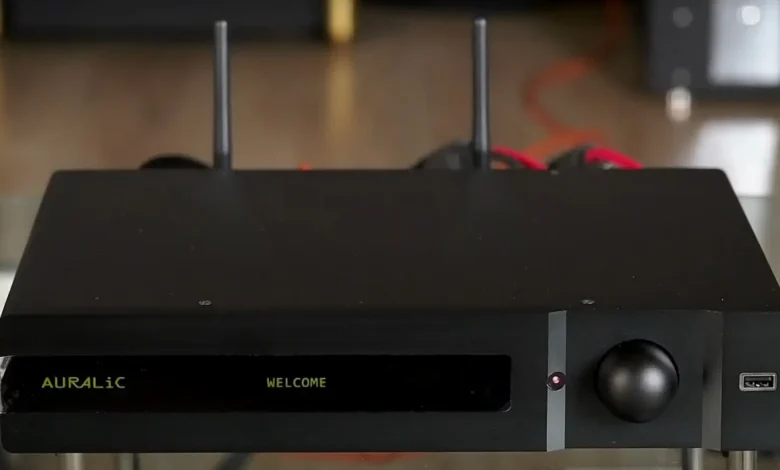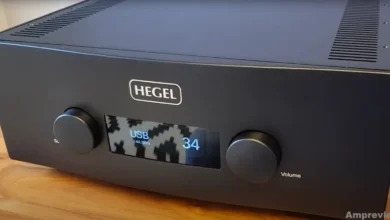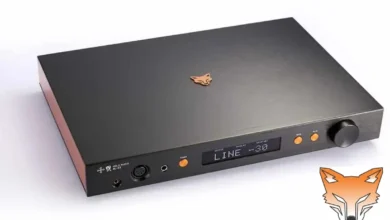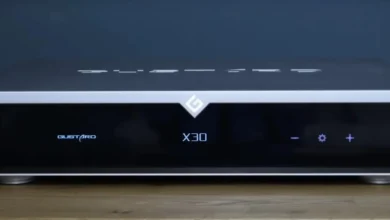

LowBeats author Bernhard Rietschel tested the latest coup from Auralic, the Auralic Polaris, for several weeks. In view of the compact housing, which after all contains a powerful integrated amplifier plus a fully equipped streamer, he rightly asked himself the question: is such a device more hi-fi fast food or already an audiophile designer drug? The answer was surprisingly clear.
Whenever the author of these lines tests good all-in-one devices, he briefly longs for a solid, steady hi-fi life without constant assembly, disassembly, and conversion, comparing, replugging, unpacking, and repacking. Without cardboard storage in the hallway and all corners and niches of the apartment that can be reached in any way. And without the stacks of devices and the tangle of cables that an active test operation sometimes entails.
A radical counter-utopia to the extreme, nerdy technological presence is the streaming amplifiers that have been available for several years, which can make an entire system including the player almost disappear without having to compromise too much on the sound. T+A, Linn, and Naim were pioneers of this movement, Auralic took its time and presented such an all-rounder with the Polaris just this year: a powerful integrated amplifier with digital and analog inputs, one of which can even be switched to Phono MM, and with a sophisticated streamer that supports the music services Tidal and Qobuz, any hard disks, SSDs and DLNA servers, Internet radio, Bluetooth, Airplay, Multiroom and even the playback protocol of the noble music server Roon.
The Chinese company Auralic generally does not tend to oversleep trends or follow well-trodden technological paths. On the contrary: In recent years, its developers have repeatedly caused a stir with their explosive development speed and, with the Lightning platform, have one of the most powerful and best streaming units on the market in their hands.
Again and again – for example with DSD streaming, the integration of streaming services or the integrated server function – established competitors had to watch how Auralic co-founder Xuanqian Wang and his team were already reporting that features were being implemented, while others were still in the starting blocks – or even just discussing whether a start was even possible and sensible.
The streaming heart of the Auralic Polaris is reassuringly oversized with an ARM Cortex A9 quad-core processor and plenty of RAM for the demands of a network player. It was first used in the purely digital streaming bridge Aries – a modern successor to the audiophile CD drive, so to speak, tailor-made for the USB DACs that are currently highly valued by computer audiophiles. Then the cute Aries Mini inherited its extensive capabilities, but thanks to the integrated D/A converter it was a complete player and even offered a slot for a 2.5″ hard drive or SSD in its mini housing.
The Auralic Polaris streaming integrated amplifier tested here also has this option: If you want it to be particularly neat and clean, you can integrate the server physically and logically into the Polaris, so you only have to set up this one device in your living room. Not even a network cable has to be laid to the Polaris because the device connects to the home WLAN via the modern 802.11ac standard, which guarantees music enjoyment without dropouts even with super-high-resolution music files. Only power and speakers have to be wired classically.
You May Like: Naim Uniti Nova Review
You can see that the Auralic Polaris is not cheap. With its very precisely fitting housing, the cleanly centered and wobble-free rotary encoder button, and the amber-colored, fine-resolution dot-matrix display, it looks classy in a reserved way – an impression that unfortunately does not continue with the remote control in the cheap DVD player style.
In streaming mode, the infrared spark is hardly used anyway, but primarily Auralic’s own “Lightning DS” app, for example on an iPad: It guides the owner through the setup of the streamer and requires a little patience from time to time, but always remains detailed, clear and logical.
If the streamer is ready to go and if the latest firmware is installed (this is done automatically via the network), the app will ask which music library should be used. If you want to access an existing DLNA server (e.g. on a NAS), then simply let the app take over its data and cover preview images.
The app buffers all lists locally instead of pulling them from the server with each search. As a result, the albums load and scroll very quickly and smoothly during later searches, even if a collection contains a few thousand albums.
However, operation with your server intelligence is even better integrated and more convenient. The integrated Lightning server is a full-fledged DLNA server, which, however, has practical sorting criteria such as file format, modification date, or data rate ahead of its typical NAS colleagues and which, once it is running, is also available to any other streamer in the same network. So you can switch from the main system in the living room to an inexpensive streaming box in the kitchen or the DLNA-enabled surround receiver in the basement without having to get used to a new server sorting every time.
Since the Lightning Server (like any other server program) first reads the metadata of all existing music files, it takes some time to set it up: the test device combed through the approximately 30,000 titles on the author’s NAS in just under an hour. The limiting factor was probably not the Auralic Polaris, but the read and access times of the ten-year-old network storage.
You May Like:
In addition to NAS disks in the home network, the Lightning server can also search and sort USB storage devices connected directly to the Polaris or the internally pluggable 2.5″ disk mentioned above and offer them clearly for selection via the app. According to an update that has already been announced, it should also be possible to combine several storage locations into one comprehensive collection.
At the time of the test, you still had to decide between internal storage, USB, and network hard drive. The change is very quick, however, because the Lightning Server remembers the different databases and then apparently does not have to create them from scratch, but only has to retrieve them again.
Regardless of the storage medium, the Auralic Polaris plays every hi-fi-relevant file format, including exotic ultra-high-res resolutions that can reach up to eight times the standard sampling rate in the DSD one-bit format, i.e. up to 11 megahertz (DSD512). With PCM formats, the fun goes up to 352.8 or 384 kHz with up to 32-bit data words. “Fun” is relative here, because there is very little music in DSD512 or PCM-based formats beyond 24bit/192kHz.
On the other hand, “normal” HiRes, i.e. around 24bit/96kHz, is completely different, which is available from providers such as Highresaudio.com in an impressive selection that also includes not only jazz, classic, and audiophile piling, but also many rock and alternative records.
The fact that the HighRes downloads often sound better than their CD or streaming equivalents, regardless of the music style, does not even have to be directly related to their higher sampling rate or the additional bits, but is often simply because the downloads were mastered differently about their audiophile target group, namely with more dynamics and less compression.
In addition to many other unanswered questions, this fact is also an argument against MQA’s “One file for all resolutions” approach ( see also the LowBeats TV interview with MQA inventor Bob Stuart). If the mass market and the high-end niche can/must be served with the same product, this standard file will logically (must) be optimized for the mass market. The possibility of differentiating the target group accordingly when mastering is retained in principle, but is likely to be used much less frequently.
As a reminder, ordinary streamers treat MQA files or streams like regular FLAC with a resolution close to the CD standard. The high-res subtleties only come to light with a proprietary decoder, which multiplies the basic clock rate of 44.1 or 48kHz accordingly. Auralic takes a spicy middle ground here: Xuanqian Wang did not license the format, but programmed his own decoder algorithms for it – which seem to work and in the listening test deliver very similar results to those that the author has already received in his experiments with “official” MQA equipment. Ideally, the comparison would be like the Vivaldi cantatas sung by soprano Tone Wik on the album Bellezza Crudel (www.2L.no), where the MQA streams streamed by Tidal and unpacked in the Polaris sounded better than the normal 44.1/16 FLACs from the NAS. Namely, in a peculiar way, at the same time more focused, finer, and richer in substance – a characteristic that also applies to the classic HighRes file, which is compatible with all players, i.e. it is not specific to the MQA format.
This draws its appeal mainly from the fact that the streaming service Tidal has thousands of MQA-coded albums available as part of the normal “Tidal HiFi” subscription at no additional charge. HighRes file compatible with all players applies, i.e. it is not specific to the MQA format. This draws its appeal mainly from the fact that the streaming service Tidal has thousands of MQA-coded albums available as part of the normal “Tidal HiFi” subscription at no additional charge. HighRes file compatible with all players applies, i.e. it is not specific to the MQA format. This draws its appeal mainly from the fact that the streaming service Tidal has thousands of MQA-coded albums available as part of the normal “Tidal HiFi” subscription at no additional charge.
In the test, of course, not only Tidal was on the playlist, but also digital material from the local NAS server and analog material from the Linn LP12, both via the internal phono input of the Auralic Polaris and via external phono stages, which were then connected as high-level sources via the line input. However, the signal path is not 100% analog, since all signals have to pass through Auralic’s hybrid volume control, which combines coarse, analog-switched 12dB level stages with digital fine adjustment.
Compared to purely digital controls, this offers the advantage that the useful signals of digital origin always retain all resolution-relevant bits, even with minimum volume settings. Analog signals, on the other hand, first have to pass through an A/D converter in order to then travel through the Polaris on the same path as their digital relatives.
Vinyl purists will therefore probably not make the Auralic Polaris their first choice – given its opulent equipment with physical digital inputs, streaming standards, and integrated music services, it would also be completely overqualified. On the other hand, its MM phono input sounds very good and you don’t notice the detour through the digital domain in normal listening. In any case, the very special beauty of good records is fully preserved – an experience that may surprise some, especially since in the Polaris, to top it all off, a Class D power amplifier from Hypex and the associated switched-mode power supply also serves as the power source. However, this has a huge advantage: lots of power, but a compact design and low weight (4.5 kilos). Auralic specifies power values of 2 x 180 watts at 4 ohms (or 2 x 120 at 8 ohms). After the long and sometimes very loud listening tests, I can only say that this is believable.
This is what the Auralic Polaris sounds like
Subjectively, the sonic result is paradoxically even more “analog” than with many fully analog chains: the Polaris makes music powerfully, silky and full, more pleasurable than analytical, more supple than crystalline – and it does not give up these characteristics even at high volumes and/or with more demanding loudspeakers. Among the compact high-end streaming amps – which also include the smaller Uniti and DSM models from Naim and Linn respectively – the Auralic is the one with the smoothest power delivery.
The powerful, relaxed tuning is emphasized by the choice of D/A converter: As with the Aries Mini, Auralic uses the inconspicuous, natural and extremely clean-sounding SABRE9016 chip from ESS. Its characteristics can be subtly influenced by four selectable digital filter algorithms – the author ultimately preferred listening with his older Naim speakers in the “Precise” position, which brought a welcome touch of extra freshness, with the new Klipsch Forte III with the options “Smooth” or “Balanced”. This has nothing to do with tone control.
The digital filter is an integral part of the D/A conversion and removes the high-frequency by-products that are inevitably generated during the conversion. The different algorithms have practically no influence on the frequency response in the audible range, can, however, affect the sound impression via their time and impulse behavior. You can access this setting via the front display and either the remote control or the multifunction rotary pushbutton on the device. Balance, absolute phase, volume presets, display brightness and the assignment of the two analog connections can also be set here.
All this is extremely well thought out and practical. In everyday use – and in comparison to the competitors mentioned – there is only one small annoying thing, but according to Auralic, it is already being fixed: At the time of the test, the Polaris could only be accessed via its app if the streamer was already selected as the source on the device. When changing from one of the analog or digital inputs, you first had to switch to the remote control and only then start the app. Unconditional accessibility and full app control in all operating modes would reinforce the impression of perfect integration. From a hi-fi point of view, a turntable makes sense as an additional source – for all the music that is available on disk or has never been released in digital form. Everything, That has been released digitally is best played back with the integrated streamer (possibly after having transferred it to the hard drive beforehand). External drives bring no advantage over the internal player clocked by Auralic’s high-precision femto clock, and of course, external complete players do not anyway, since their output signal would be A/D and D/A converted in the Polaris anyway.
Conclusion Auralic Polaris
One could blame the Auralic Polaris for getting in the way of source upgrades. That’s a purely academic limitation, though, as his greatest achievement is creating a situation at home where you don’t have to think about upgrades and hi-fi in general. It may be that the Polaris is also a highly attractive device for many demanding beginners. However, it is a drop-out device – ideal for people who, after many years with ambitious hi-fi and the complexity that it usually entails, are longing for a simpler solution that does not involve compromises: once the right speakers have been found, the only thing that remains to deal with the topic meaningfully is to search for new, exciting music—the solid above.
Pros And Cons Of Auralic Polaris Streaming Amplifier
Pros:
- All-in-One Solution: Combines an amplifier, DAC, and network streamer in a single unit, saving space and reducing clutter.
- Powerful Performance: Delivers 120 watts per channel, suitable for driving a wide range of speakers effectively.
- High-Resolution Audio Support: Compatible with a variety of high-resolution audio formats, ensuring exceptional sound quality.
- Versatile Connectivity: Offers multiple input options, including USB, Ethernet, Bluetooth, and more, for seamless integration with various devices.
- User-Friendly App: The Auralic app provides an intuitive interface for streaming, managing music, and controlling playback.
- Multi-Room Capability: Supports multi-room audio setups, allowing you to enjoy music throughout your home.
- Sleek Design: Modern aesthetic that fits well in any audio setup.
Cons:
- Price Point: Higher cost compared to traditional amplifiers or separate components, which may not be suitable for all budgets.
- Learning Curve: New users may need time to familiarize themselves with the app and all the features.
- Limited Phono Input: This does not include a built-in phono stage for turntables, requiring an external preamp for vinyl playback.
- No HDMI Inputs: Lacks HDMI inputs, which may limit integration with home theater systems.
FAQs Auralic Polaris Streaming Amplifier:
1. What is the power output of the Auralic Polaris?
Ans: The Auralic Polaris delivers 120 watts per channel into 8 ohms, providing plenty of power for most speakers.
2. Does the Polaris support high-resolution audio?
Ans: Yes, the Polaris supports various high-resolution audio formats, including WAV, FLAC, ALAC, DSD, and more.
3. Can I connect my turntable to the Auralic Polaris?
Ans: The Polaris does not have a built-in phono input, so you’ll need an external phono preamp to connect your turntable.
4. What streaming services are compatible with the Auralic Polaris?
Ans: The Polaris supports popular streaming services like Tidal, Qobuz, Spotify, and more, making it easy to access your favorite music.
5. How do I control the Auralic Polaris?
Ans: You can control the Polaris using the Auralic app available for iOS and Android devices, or through the physical controls on the unit itself.
6. Is the Auralic Polaris suitable for multi-room audio?
Ans: Yes, the Polaris supports multi-room setups, allowing you to enjoy synchronized music playback across different rooms in your home.
7. What input options does the Auralic Polaris have?
Ans: The Polaris offers multiple input options, including USB, Ethernet, Bluetooth, and digital inputs, allowing for versatile connectivity with various devices.
8. Is the Auralic Polaris easy to set up?
Ans: Yes, the setup process is straightforward, especially if you follow the instructions in the user manual. The app also guides you through the initial setup.
9. Does the Auralic Polaris come with a warranty?
Ans: Yes, the Auralic Polaris typically comes with a manufacturer’s warranty, but the specifics may vary by retailer, so it’s best to check the warranty details at the time of purchase.
10. Can I use the Auralic Polaris with a home theater system?
Ans: While the Polaris excels in stereo audio, it may not be the best choice for a home theater system due to the lack of HDMI inputs and surround sound processing.










GIPHY App Key not set. Please check settings